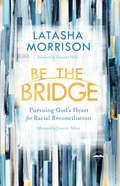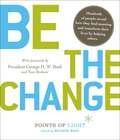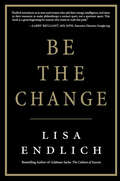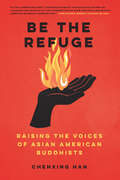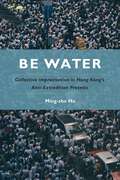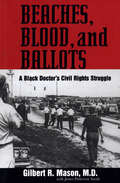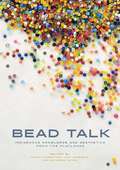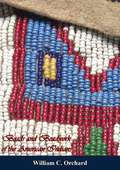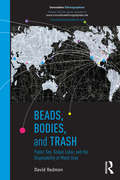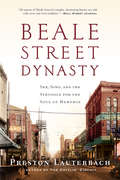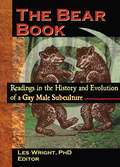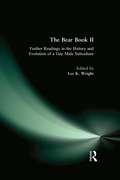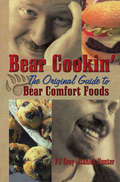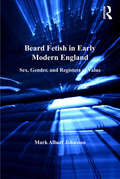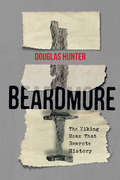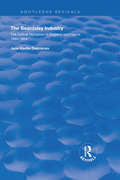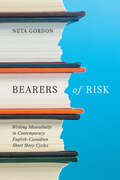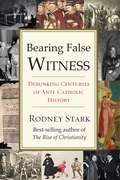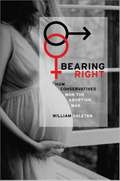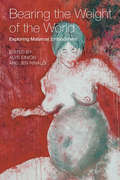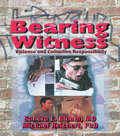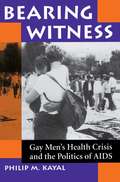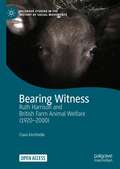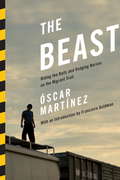- Table View
- List View
Be the Bridge: Pursuing God's Heart for Racial Reconciliation
by Latasha MorrisonA leading advocate for racial reconciliation offers a clarion call for Christians to move toward relationship and deeper understanding in the midst of a divisive culture.With racial tensions as high within the church as outside the church, it is time for Christians to become the leaders in the conversation on racial reconciliation. This power-packed guide helps readers deepen their understanding of historical factors and present realities, equipping them to participate in the ongoing dialogue and to serve as catalysts for righteousness, justice, healing, transformation, and reconciliation.
Be the Change!
by George H. Bush David Hume Kennerly Michelle Nunn Tom BrokawBe the Change celebrates the personal transformations of men and women who, by working to change the world, changed themselves. Featuring interviews with over 1,000 volunteers, from everyday people to business and community leaders to celebrities, the book combines hands-on advice on ways to get involved with enlightening real-life stories from those who did. Inspirational yet practical, it's the perfect companion for readers who want to stop daydreaming about a more fulfilling life and a better world and take action to do so.Includes forewords by President George H. W. Bush and Tom Brokaw
Be the Change: Candid Conversations with the World's Most Successful Philanthropists
by Lisa EndlichMeet the men and women whose deeply personal philanthropy is dramatically changing the way we think about givingThere are 8.6 million millionaires in the United States, and these numbers are set to rise in what will be the biggest intergenerational wealth transfer in history. As $41 trillion dollars (or over three times the national GDP) moves from the World War II generation to their baby- boomer children over the next couple of decades, it will become imperative that the beneficiaries of this wealth—even those not joining the ranks of the superrich—begin thinking about philanthropy, perhaps for the first time in their adult lives. Here they will find the personal journeys of the most successful givers of their generation. This new generation of wealth has already begun to change the face of philanthropy and to reshape the entire nonprofit sector. In Be the Change, bestselling author Lisa Endlich presents eleven compelling profiles of this twenty-first century generosity. Through candid, revealing, and often surprising interviews, readers will venture into the hearts and minds of the top names in philanthropy today—men and women who have chosen to use their immense riches and influence to meaningfully improve the lives of others in the most dramatic ways. These intimate conversations include in-depth interviews with:Melinda Gates, one of the driving forces behind the largest philanthropic organization the world has ever seen;Bob and Suzanne Wright, he's the former vice chairman of GE and longtime head of NBC Universal and their Autism Speaks has brought awareness of autism onto the national and international stage; Paul Tudor Jones, founder of Tudor Investments and the Robin Hood Foundation;Peter Bloom, founding chairman of the groundbreaking DonorsChoose.org.From Connie Duckworth, a former Goldman Sachs partner, who brings steady employment to Afghani women and education to them and their children, to Johann Olav Koss, an Olympic gold medalist who now strives to give children in the direst circumstances the chance to play, these philanthropists demonstrate that giving doesn't begin or end with a signed check. They grant Endlich exclusive access to the stories of how they learned from early failures and developed a personal, sustainable way of giving, and they also share the catalyzing moment when they saw a problem so heartbreaking they simply could not turn away. In doing so, these new philanthropists offer valuable lessons—ones that will inspire readers to start giving, keep giving, and become the change they want to see in the world.
Be the Refuge: Raising the Voices of Asian American Buddhists
by Chenxing HanA must-read for modern sanghas--Asian American Buddhists in their own words, on their own terms. Despite the fact that two thirds of U.S. Buddhists identify as Asian American, mainstream perceptions about what it means to be Buddhist in America often whitewash and invisibilize the diverse, inclusive, and intersectional communities that lie at the heart of American Buddhism. Be the Refuge is both critique and celebration, calling out the erasure of Asian American Buddhists while uplifting the complexity and nuance of their authentic stories and vital, thriving communities. Drawn from in-depth interviews with a pan-ethnic, pan-Buddhist group, Be the Refuge is the first book to center young Asian American Buddhists' own voices. With insights from multi-generational, second-generation, convert, and socially engaged Asian American Buddhists, Be the Refuge includes the stories of trailblazers, bridge-builders, integrators, and refuge-makers who hail from a wide range of cultural and religious backgrounds. <p><p> Championing nuanced representation over stale stereotypes, Han and the 89 interviewees in Be the Refuge push back against false narratives like the Oriental monk, the superstitious immigrant, and the banana Buddhist--typecasting that collapses the multivocality of Asian American Buddhists into tired, essentialized tropes. Encouraging frank conversations about race, representation, and inclusivity among Buddhists of all backgrounds, Be the Refuge embodies the spirit of interconnection that glows at the heart of American Buddhism.
Be Water: Collective Improvisation in Hong Kong's Anti-Extradition Protests
by Ming-sho HoDuring the eventful summer of 2019 in Hong Kong, the Be Water Revolution formed to resist the proposed extradition of fugitives to mainland China’s courts. With its name derived from martial arts master Bruce Lee’s adage to be “formless and shapeless like water,” the movement turned out to be the city’s largest episode of contentious politics and was unique for using impromptu communication among participants and the absence of central leadership. In Be Water, Ming-sho Ho examines the dynamics of the city-wide uprising from the perspective of agency power. He seeks to understand how numerous and anonymous Hongkongers contributed to this epoch-making campaign as well as how they responded to the full-scale state repression that enveloped them. Ho praises and questions the durability of the inventive Be Water Revolution and how the activists encouraged protests spontaneously, through interpersonal networks and by voluntarily collaborating with strangers at great personal risk. Ho posits a new concept of “collective improvisation” to make sense of such a decentralized yet creative way of protesting. Be Water seeks to understand the rise and long afterlife of this movement and illustrate its efficacy. As Ho shows, these dynamics of collective improvisation have implications for contemporary protest movements around the world.
Beaches, Blood, and Ballots: A Black Doctor's Civil Rights Struggle
by Gilbert R. Mason Sr.This book, the first to focus on the integration of the Gulf Coast, is Dr. Gilbert R. Mason's eyewitness account of harrowing episodes that occurred there during the civil rights movement. Newly opened by court order, documents from the Mississippi Sovereignty Commission's secret files enhance this riveting memoir written by a major civil rights figure in Mississippi. He joined his friends and allies Aaron Henry and the martyred Medgar Evers to combat injustices in one of the nation's most notorious bastions of segregation. In Mississippi, the civil rights struggle began in May 1959 with “wade-ins.” In open and conscious defiance of segregation laws, Mason led nine black Biloxians onto a restricted spot along the twenty-six-mile beach. A year later more wade-ins on beaches reserved for whites set off the bloodiest race riot in the state's history and led the U.S. Justice Department to initiate the first-ever federal court challenge of Mississippi's segregationist laws and practices. Simultaneously, Mason and local activists began their work on the state's first school desegregation suit. As the coordinator of the strategy, he faced threats to his life. Mason's memoir gives readers a documented journey through the daily humiliations that segregation and racism imposed upon the black populace—upon fathers, mothers, children, laborers, and professionals. Born in 1928 in the slums of Jackson, Mason acknowledges the impact of his strong extended family and of the supportive system of institutions in the black neighborhood. They nurtured him to manhood and helped fulfill his dream of becoming a physician. His story recalls the great migration of blacks to the North, of family members who remained in Mississippi, of family ties in Chicago and other northern cities. Following graduation from Tennessee State University and Howard University Medical College, he set up his practice in the black section of Biloxi in 1955 and experienced the restrictions that even a black physician suffered in the segregated South. Four years later, he began his battle to dismantle the Jim Crow system. This is the story of his struggle and hard-won victory.
Bead Talk: Indigenous Knowledge and Aesthetics from the Flatlands (paskwāwi masinahikewina/Prairie Writing #1)
by Carmen Robertson Judy Anderson Katherine BoyerSewing new understandings Indigenous beadwork has taken the art world by storm, but it is still sometimes misunderstood as static, anthropological artifact. Today’s prairie artists defy this categorization, demonstrating how beads tell stories and reclaim cultural identity. Whether artists seek out and share techniques through YouTube videos or in-person gatherings, beading fosters traditional methods of teaching and learning and enables intergenerational transmissions of pattern and skill. In Bead Talk, editors Carmen Robertson, Judy Anderson, and Katherine Boyer gather conversations, interviews, essays, and full-colour reproductions of beadwork from expert and emerging artists, academics, and curators to illustrate the importance of beading in contemporary Indigenous arts. Taken together, the book poses and responds to philosophical questions about beading on the prairies: How do the practices and processes of beading embody reciprocity, respect, and storytelling? How is beading related to Indigenous ways of knowing? How does beading help individuals reconnect with the land? Why do we bead? Showcasing beaded tumplines, text, masks, regalia, and more, Bead Talk emphasizes that there is no one way to engage with this art. The contributors to this collection invite us all into the beading circle as they reshape how beads are understood and stitch together generations of artists.
Beads and Beadwork of the American Indians: A Study Based On Specimens In The Museum Of The American Indian, Heye Foundation
by William C. OrchardThis book and Orchard's book on porcupine quill decoration, form the foundation for almost every text on Indian arts and crafts that has been written since their publication and they remain superior to most.Not only is this book an in-depth study of bead technology, but it considers in greater detail than any similar work the history, use and distribution of North (and South) American beadwork art from prehistoric to relatively modern times. The author pays needed attention to the variety of materials used and the design motifs of finished beadwork, as well as the role of early Europeans, whose colorful trade beads (shown in beautiful color plates) had such a tremendous impact on Indian economics and material culture. Included are discussions, photographs and illustrations of shell, pearl, bone, stone, metal, and trade beads. Wampum is described in great detail and odd forms and materials, which include seed, basketry, wooden, gum, earthenware, dried otter's liver, and native manufacture of glass beads are also described. There is also a very interesting section on drilling holes in beads.All of the basic techniques of beadwork are explored and illustrated. These include woven beadwork (square weave, bias weave, and net-like weave), sewing techniques and edgings, bead inlays and beaded baskets. There are 16 color plates, 26 black and white plates and 136 figures which include drawings and photographs. The color plates include chevron beads, polychrome trade beads, and outstanding examples of native beadwork from Alaska to Ecuador.-Print ed.
Beads, Bodies, and Trash: Public Sex, Global Labor, and the Disposability of Mardi Gras
by David RedmonBeads, Bodies, and Trash merges cultural sociology with a commodity chain analysis by following Mardi Gras beads to their origins. Beginning with Bourbon Street of New Orleans, this book moves to the grim factories in the tax-free economic zone of rural Fuzhou, China. Beads, Bodies, and Trash will increase students’ capacity to think critically about and question everyday objects that circulate around the globe: where do objects come from, how do they emerge, where do they end up, what are their properties, what assemblages do they form, and what are the consequences (both beneficial and harmful) of those properties on the environment and human bodies? This book also asks students to confront how the beads can contradictorily be implicated in fun, sexist, unequal, and toxic relationships of production, consumption, and disposal. With a companion documentary, Mardi Gras Made in China, this book introduces students to recording technologies as possible research tools.
Beale Street Dynasty: Sex, Song, and the Struggle for the Soul of Memphis
by Preston LauterbachThe vivid history of Beale Street--a lost world of swaggering musicians, glamorous madams, and ruthless politicians--and the battle for the soul of Memphis. Following the Civil War, Beale Street in Memphis, Tennessee, thrived as a cauldron of sex and song, violence and passion. But out of this turmoil emerged a center of black progress, optimism, and cultural ferment. Preston Lauterbach tells this vivid, fascinating story through the multigenerational saga of a family whose ambition, race pride, and moral complexity indelibly shaped the city that would loom so large in American life. Robert Church, who would become "the South's first black millionaire," was a mulatto slave owned by his white father. Having survived a deadly race riot in 1866, Church constructed an empire of vice in the booming river town. He made a fortune with saloons, gambling, and--shockingly--white prostitution. But he also nurtured the militant journalism of Ida B. Wells and helped revolutionize American music through the work of composer W.C. Handy, the man who claimed to have invented the blues. In the face of Jim Crow, the Church fortune helped fashion the most powerful black political organization of the early twentieth century. Robert and his son, Bob Jr., bought and sold property, founded a bank, and created a park and auditorium for their people finer than the places whites had forbidden them to attend. However, the Church family operated through a tense arrangement with the Democrat machine run by the notorious E. H. "Boss" Crump, who stole elections and controlled city hall. The battle between this black dynasty and the white political machine would define the future of Memphis. Brilliantly researched and swiftly plotted, Beale Street Dynasty offers a captivating account of one of America's iconic cities--by one of our most talented narrative historians.
The Bear and, His Sons: Masculinity in Spanish and Mexican Folktales
by James M. TaggartJames Taggart contrasts how two men-a Spaniard and an Aztec-speaking Mexican-tell such tales as "The Bear's Son. " He explores how their stories present different ways of being a man in their respective cultures. He also focuses on how fathers reproduce different forms of masculinity in their sons, showing how fathers who care for their infant sons teach them a relational masculinity based on a connected view of human relationships.
The Bear Book: Readings in the History and Evolution of a Gay Male Subculture
by Les WrightThe Bear Book brings together an impressive range of bear--usually big, hairy men who favor full-face beards and prefer to wear jeans and flannel shirts--viewpoints to explore this unique social and cultural phenomenon that stretches from America to western Europe to Australia! On the personal level, you learn what beardom means to different people in their daily lives, and on a broader level, its cultural implications for not only the gay community, but also society as a whole. As this book moves across the wide spectrum of bear identities, you learn about the defining forces of identity, the significance of differences among masculinities, and the shapings of the bear movement from different viewpoints.The Bear Book is the first compilation of sociological and cultural analytical investigations of the contemporary gay bear phenomenon. To this end, Editor Les Wright brings together both objective and subjective viewpoints to create a forum where bears can speak for themselves. Through their voices, you’ll learn about: bears and sexual identity gay male iconography socializing on the Internet sexual politics (gender, class, “looks-ism,” and body image) gay mass media, the single most powerful force in the current construction of ”bears” bears, power, and glamor bear-as-image vs. bear-as-attitudeGays, lesbians, lesbigay scholars, bears, and social scientists are sure to find The Bear Book thought-provoking and insightful as it broaches questions such as: Are bears caught up in a utopian-romantic impulse to reinvent themselves? What was radical lesbianism&’s impact on the bear movement? To what extent are bears only another group of exploited consumers in a fragmented market system? And, is it possible to establish social liberation through enslavement to your sexual passions? For both your pleasure and your education, The Bear Book examines nearly every corner of beardom, including bear history, identity, social spaces, iconography, and its constituency abroad.
The Bear Book II: Further Readings in the History and Evolution of a Gay Male Subculture
by Les WrightHere is a serious discussion of an emerging gay subculture! Take another fascinating journey into the bear's den with the latest offering from Les Wright, author of The Bear Book. The Bear Book II will show you the contrast between the media image of the fun-loving, carefree bear man and the health, image, psychological, technological, and sexual concerns of bears living in the real world. A continuation of The Bear Book (1997), this study of typically big, hairy, and bearded gay men explores bears on a societal and personal level, giving a wide voice to bears of all ages, nationalities, and cultures. Among the topics The Bear Book II: Further Readings in the History and Evolution of a Gay Male Subculture discusses are: health concerns of bears bear body images self-esteem issues for bears physical and psychological bear attributes as portrayed in the media versus actual individual accounts social and sexual institutions in the bear community the role of the Internet in creating a global bear subcultureThe Bear Book II will help you to understand the life of a bear. This unique book, the only serious exploration of this topic, offers documentation of a subculture in the making, complete with subjective and analytical perspectives that support this example of postmodern cultural anthropology.
Bear Cookin': The Original Guide to Bear Comfort Foods
by PJ Gray Stanley HunterPlease DO feed the bears! Bear Cookin': The Original Guide to Bear Comfort Foods takes a good-natured approach to good eating, presenting home-style recipes with a light-hearted touch. Aimed at husky, hairy gay men-and their admirers-the book presents convenient and satisfying recipes for anyone who loves to cook-and eat! Bear Cookin' includes helpful hints, "tributes" to favorite foods, and meal suggestions for breakfast, lunch, dinner-and everything in between-that are guaranteed to please burly bears with big appetites. From lip-smacking snacks to belt-loosening main courses, Bear Cookin&’ is stuffed with easy-to-follow recipes for the hearty and delicious comfort foods bears crave: burgers, meatloaf, biscuits with sausage gravy, pasta, potatoes, beans, muffins and bread, cheesecake, puddings and pies, and homemade ice cream. Collected from family and friends and perfect for summer picnic baskets or winter "hibernation" dinners, these filling and flavorful recipes are presented with the love for good food that makes life worth living. Bear Cookin' includes recipes for: (Touch My) Monkey Bread What-A-Crock Pot Stew What&’s It All About ... Alfredo Polar Bear Chili Fur-ocious Pot Roast and odes to the wonders of Cool Whip®, Bisquick®, and Velveeta®! Bear Cookin': The Original Guide to Bear Comfort Foods also includes serving ideas and suggestions for making the best use of your cooking utensils. This book is a wonderful addition to any kitchen-bear or otherwise!
Beard Fetish in Early Modern England: Sex, Gender, and Registers of Value (Women And Gender In The Early Modern World Ser.)
by Mark Albert JohnstonFocusing on representations of beards in English Renaissance culture, this study elucidates how fetish objects validate ideological systems of power by materializing complex value in multiple registers. Providing detailed discussions of not only bearded men but also beardless boys, bearded women, and half-bearded hermaphrodites, author Mark Albert Johnston argues that attending closely to early modern English culture's treatment of the beard as a fetish object ultimately exposes the contingency of categories like sex, gender, age, race, and sexuality. Johnston mines a diverse cross-section of contemporary discourses -- adult and children’s drama, narrative verse and prose, popular ballads, epigrams and proverbs, historical accounts, pamphlet literature, diaries, letters, wills, court records and legal documents, medical and surgical manuals, lectures, sermons, almanacs, and calendars -- in order to provide proof for his cultural claims. Johnston’s evidence invokes some of the period’s most famous voices -- William Shakespeare, Ben Jonson, John Lyly, Phillip Stubbes, John Marston, George Chapman, Thomas Dekker, Thomas Middleton, and Samuel Pepys, for example -- but Johnston also introduces us to an array of lesser-known Renaissance authors and playwrights whose works support the notion that the beard was a palimpsestic site of contested meaning at which complex and contradictory values clash and converge. Johnston’s reading of Marxist, Freudian, and anthropological theories of the fetish phenomenon acknowledges their divergent emphases -- erotic, economic, racial and religious -- while suggesting that the imbrication of diverse registers that fetish accomplishes facilitates its cultural and psychic naturalizing function.
Beardmore: The Viking Hoax That Rewrote History (Carleton Library Series #246)
by Douglas HunterIn 1936, long before the discovery of the Viking settlement at L'Anse aux Meadows, the Royal Ontario Museum made a sensational acquisition: the contents of a Viking grave that prospector Eddy Dodd said he had found on his mining claim east of Lake Nipigon. The relics remained on display for two decades, challenging understandings of when and where Europeans first reached the Americas. In 1956 the discovery was exposed as an unquestionable hoax, tarnishing the reputation of the museum director, Charles Trick Currelly, who had acquired the relics and insisted on their authenticity. Drawing on an array of archival sources, Douglas Hunter reconstructs the notorious hoax and its many players. Beardmore unfolds like a detective story as the author sifts through the voluminous evidence and follows the efforts of two unlikely debunkers, high-school teacher Teddy Elliott and government geologist T.L. Tanton, who find themselves up against Currelly and his scholarly allies. Along the way, the controversy draws in a who’s who of international figures in archaeology, Scandinavian studies, and the museum world, including anthropologist Edmund Carpenter, whose mid-1950s crusade against the find’s authenticity finally convinced scholars and curators that the grave was a fraud. Shedding light on museum practices and the state of the historical and archaeological professions in the mid-twentieth century, Beardmore offers an unparalleled view inside a major museum scandal to show how power can be exercised across professional networks and hamper efforts to arrive at the truth.
The Beardsley Industry: The Critical Reception in England and France 1893 – 1914 (Routledge Revivals)
by Jane Haville DesmaraisFirst published in 1998, this is the first book to examine the critical reception accorded to Beardsley’s work. For most of his short working life fierce debate raged in Britain over the merit of Aubrey Beardsley’s black and white drawings. Applauded for their technical skill, they were as often deplored for their ‘slimy nastiness’, their fin-de-siècle decadence and their foreign styles. There are ‘tainted whiffs from across the channel which lodge the Gallic germs in our lungs. Our Beardsleys have identical symptoms with Verlaine, Degas, Le Grand, Forain, and might quite well be sick from infection’ stormed Margaret Armour in the Magazine of Art. Jane Haville Desmarais opens with an account of the English response, exploring the fascinating interplay between Beardsley’s exploitation of the new media to shape his public persona and promote his work and the critics’ use of his life and art to articulate the fears and anxieties of the English fin de siècle. The second half of the book moves to France and deals with a different set of preoccupation. The French perceived Beardsley as the natural inheritor of the mantle of Pre-Raphaelitism. His work remained current largely through the interest of the Symbolists and, in particular, Robert de Montesquiou who celebrated Beardsley’s picturing of the fantasy realms of desire. The intriguing study of two very different critical traditions casts light on key issues of art history and literary studies, in particular the relationship between critical response and social perception. With 21 black and white illustrations, the book also has invaluable appendices which include a bibliography of criticism and comment on the work of Aubrey Beardsley between 1893 and 1914.
Bearers of Risk: Writing Masculinity in Contemporary English-Canadian Short Story Cycles
by Neta GordonThe short story and the short story cycle have long been considered a marginal genre, free to make room for fresh or risk-taking voices. But in thematizing masculinity in crisis, the genre uses the premise of the marginal to elevate recuperative masculinity politics and nostalgia for traditional patriarchy.Despite the scholarly tendency to link marginal genres and marginalized voices, features of the CanLit infrastructure – including genre criticism and literary prize culture – are complicit in normalizing hegemonic masculinity and the Settler colonial project. Bearers of Risk examines how male Canadian writers mobilize the early twenty-first-century short story cycle as an illustration of post-9/11 recuperative masculinity politics, exposing the tendency to position White, heteronormative men’s viewpoints as objective. Neta Gordon introduces the civil bearer of risk, a figure who comprehends the position of men as being marked by or for failure, and who reasserts masculine authority as civil duty towards community. This book looks at contemporary experimental short story cycles, debut cycles by ethnically minoritized and immigrant writers, and cycles unified by setting, whether suburban, urban, or rural.Bearers of Risk unsettles popular notions of the inherent outsider status of the short story cycle while also scrutinizing expressions of recuperative masculinity politics through which men assert their right to reclaim the centre.
Bearing False Witness
by Rodney Stark<P>The following historical statements all appear in well-established textbooks, and have become part of our common culture. Which of them would you say are true? <P>* The Catholic Church incited and actively colluded in nearly two millennia of anti-Semitic violence, and Pope Pius XII is still rightfully known as ‘Hitler’s Pope’. <P>* Only recently have we become aware of ancient and remarkably enlightened Christian gospels, which narrow-minded Catholic authorities tried to suppress. <P>* Once in power as the official Church of Rome, Christians quickly and brutally persecuted paganism out of existence. <P>* The fall of Rome and the ascendancy of the Church precipitated Europe’s decline into a millennium of ignorance and backwardness, which lasted until the Renaissance. <P>* Initiated by the pope, the Crusades were but the first bloody chapter in the history of unprovoked and brutal Christian colonialism.
Bearing Right: How Conservatives Won the Abortion War
by William SaletanIn his gripping, behind-the-scenes account, journalist William Saletan reveals exactly how, thirty years after Roe v. Wade, "pro-choice" conservatives have won the abortion war.
Bearing the weight of the world Exploring Maternal Embodiment: Exploring Maternal Embodiment
by Alys EinionThe maternal body is a site of contested dynamics of power, identity, experience, autonomy, occupation, and control. Representations of the maternal body can mis/represent the childbearing and mothering form variously, often as monstrous, idealized, limited, scrutinized, or occupied, whilst dominant discourses limit motherhood through social devaluation. The maternal body has long been a hypervisible artifact: at once bracketed out in the interest of elevating the contributions of sperm-carriers or fetal status; and regarded with hostility and suspicion as out of control. Such arguments are deployed to justify surveillance mechanisms, medical scrutiny, and expectation of self-discipline.
Bearing Witness: Violence and Collective Responsibility
by Sandra L Bloom Michael ReichertBearing Witness: Violence and Collective Responsibility offers a unique layperson’s introduction to the scope and causes of violence and trauma theory and suggests ways we can all work to attack these causes. Upon completing this work, you will have a better understanding of the social causes of the violence epidemic and concrete suggestions for its long-term control.Bearing Witness addresses the cycle of violence by discussing some of the biological, psychological, social, and moral issues that go into determining whether a person will end up as a victim, perpetrator, or bystander to violent events and what happens to us when we are in one or all three of these roles. The authors look at a number of intersecting factors that play interdependent roles in creating a culture that promotes, supports, and even encourages violence. Specifically, you’ll gain invaluable insight into: trauma theory and traumatogenic forces--backdrops against which the chances of exposure to violence and the use of violence as a problemsolver are increased normal human development in the context of attachment theory and what occurs as a result of disrupted attachment bonds how rapid changes in modern society and the breakdown of the traditional family structure contribute to a level of social stress that promotes violence violence in the family, in the workplace, and in the schools--all places to which people turn for security social responses to violence--the ways in which certain responses decrease or increase the likelihood of violence the unhealthy balance of power between the genders and how violence or the threat of violence maintains this imbalance how our cultural standard of disavowing our normal emotional experience sets the stage for repeated and regular empathic failure, which leads to violenceA framework for understanding the various aspects of the problem of violence, Bearing Witness delves into the various aspects of trauma--what trauma does to the body, the mind, the emotions, and relationships--before beginning to formulate proposals for initiating processes that lead to problemsolving. Once this knowledge base has been established, the authors give you the beginnings of an outline for reorganizing society with the aim of establishing a community that is responsive to the basic human need for safety and peace.
Bearing Witness: Gay Men's Health Crisis And The Politics Of Aids
by Philip M KayalThis study tells how one community-based initiative - Gay Men's Health Crisis (GMHC) in New York - overcame the obstacles of homophobia and fear of AIDS by organizing groups of volunteers who "bear witness" to the suffering of people with AIDS. The book explores the gay community's response to AIDS, examining the relationship between personal motives for volunteering and the broader political, social and religious contexts in which people with AIDS have been largely abandoned. The author is both a sociologist and a volunteer at the Gay Men's Health Crisis.
Bearing Witness: Ruth Harrison and British Farm Animal Welfare (1920–2000) (Palgrave Studies in the History of Social Movements)
by Claas KirchhelleThis open access book is the biography of one of Britain’s foremost animal welfare campaigners and of the world of activism, science, and politics she inhabited. In 1964, Ruth Harrison’s bestseller Animal Machines triggered a gear change in modern animal protection by popularising the term ‘factory farming’ alongside a new way of thinking about animal welfare. Here, historian Claas Kirchhelle explores Harrison’s avant-garde upbringing, Quakerism, and how animal welfare debates were linked to concerns about the wider ethical and environmental trajectories of post-war Britain. Breaking the myth of Harrison as a one-hit wonder, Kirchhelle reconstructs Harrison’s 46 years of campaigning and the rapid transformation of welfare politics and science during this time. Exacerbated by Harrison’s own actions, the decades after 1964 saw a polarisation of animalpolitics, a professionalisation of British activism, and the rise of a new animal welfare science. Harrison’s belief in incremental reform allowed her to form ties to leading scientists but alienated her from more radical campaigners. Many of her 1964 demands gradually became part of mainstream politics. However, farm animal welfare’s increasing marketisation has also led to a relative divorce from the wider agenda of social improvement that Harrison once bore witness to. This is the first book to cast light on the interlinked histories of British farm animal welfare activism, science, and legislation. Its unique scope allows it to go beyond existing accounts of modern British animal welfare and will be of interest to those interested in animal welfare, environmentalism, and the behavioural sciences.
The Beast
by Francisco Goldman Oscar Martinez Daniela Maria Ugaz John WashingtonOne day a few years ago, 300 migrants were kidnapped between the remote desert towns of Altar, Mexico, and Sasabe, Arizona. A local priest got 120 released, many with broken ankles and other marks of abuse, but the rest vanished. Óscar Martínez, a young writer from El Salvador, was in Altar soon after the abduction, and his account of the migrant disappearances is only one of the harrowing stories he garnered from two years spent traveling up and down the migrant trail from Central America and across the US border. More than a quarter of a million Central Americans make this increasingly dangerous journey each year, and each year as many as 20,000 of them are kidnapped. Martínez writes in powerful, unforgettable prose about clinging to the tops of freight trains; finding respite, work and hardship in shelters and brothels; and riding shotgun with the border patrol. Illustrated with stunning full-color photographs, The Beast is the first book to shed light on the harsh new reality of the migrant trail in the age of the narcotraficantes.
